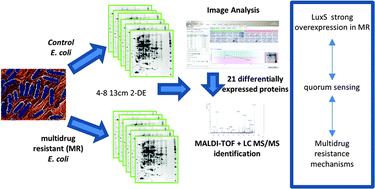Comparative proteomics to evaluate multi drug resistance in Escherichia coli†
Abstract

- This article is part of the themed collection: Italian Proteomics Association
* Corresponding authors
a Dipartimento di Scienze Zootecniche, Facoltà di Agraria, Università Degli Studi di Sassari, Sassari, Italy
b Dipartimento di Neuroscienze “B.B.Brodie”, Università degli studi di Cagliari, Cagliari, Italy
c Dipartimento di Patologia Animale, Igiene e Sanità Pubblica Veterinaria, Facoltà di Medicina Veterinaria, Università Degli Studi di Milano, Milano, Italy
d Dipartimento di Patologia e Sanità Animale, Facoltà di Medicina Veterinaria, Università di Napoli “Federico II”, Napoli, Italy
e Dipartimento di Chimica Organica e Biochimica, Università di Napoli “FedericoII”, Napoli, Italy
f
Istituto Sperimentale Italiano L. Spallanzani, via Celoria 10, Milano, Italy
E-mail:
paola.roncada@guest.unimi.it
Fax: +39 02 50318171
Tel: +39 02 50318138

 Please wait while we load your content...
Something went wrong. Try again?
Please wait while we load your content...
Something went wrong. Try again?
C. Piras, A. Soggiu, L. Bonizzi, A. Gaviraghi, F. Deriu, L. De Martino, G. Iovane, A. Amoresano and P. Roncada, Mol. BioSyst., 2012, 8, 1060 DOI: 10.1039/C1MB05385J
To request permission to reproduce material from this article, please go to the Copyright Clearance Center request page.
If you are an author contributing to an RSC publication, you do not need to request permission provided correct acknowledgement is given.
If you are the author of this article, you do not need to request permission to reproduce figures and diagrams provided correct acknowledgement is given. If you want to reproduce the whole article in a third-party publication (excluding your thesis/dissertation for which permission is not required) please go to the Copyright Clearance Center request page.
Read more about how to correctly acknowledge RSC content.
 Fetching data from CrossRef.
Fetching data from CrossRef.
This may take some time to load.
Loading related content
